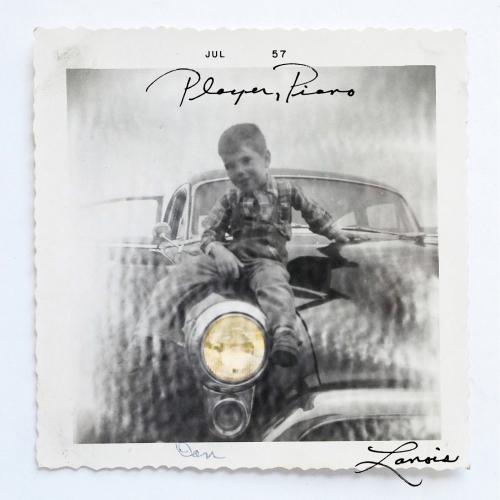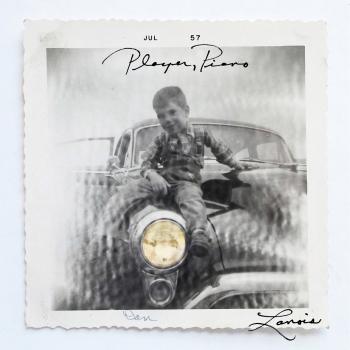
Player, Piano Daniel Lanois
Album info
Album-Release:
2022
HRA-Release:
23.09.2022
Label: Modern Recordings
Genre: Instrumental
Subgenre: Piano
Artist: Daniel Lanois
Composer: Daniel Lanois (1951)
Album including Album cover
I`m sorry!
Dear HIGHRESAUDIO Visitor,
due to territorial constraints and also different releases dates in each country you currently can`t purchase this album. We are updating our release dates twice a week. So, please feel free to check from time-to-time, if the album is available for your country.
We suggest, that you bookmark the album and use our Short List function.
Thank you for your understanding and patience.
Yours sincerely, HIGHRESAUDIO
- 1 My All 02:23
- 2 Lighthouse 03:09
- 3 Inverness 02:49
- 4 Parade 01:26
- 5 Twilight 03:25
- 6 Puebla 02:05
- 7 Eau 02:23
- 8 Zsa Zsa 02:54
- 9 Clinch 02:57
- 10 Sweet Imagination 01:37
- 11 Wild Child 02:20
- 12 Cascade 03:40
- 13 Sunday Asylum 03:01
Info for Player, Piano
Superproducer and ambient music pioneer Daniel Lanois releases his new album of instrumentals for keyboard, Player, Piano.
"Making this record transported me," says Daniel Lanois. "I got to travel to Cuba and Mexico and Jamaica. I got to visit with the ghosts of Erik Satie and Oscar Peterson and Harold Budd. I got to go back in time to my work with Brian Eno and Kate Bush and Emmylou Harris. And I did it all without ever leaving my studio."
Press play on Lanois' captivating new instrumental collection, Player, Piano, and you'll be transported, too. Each song here is a portal, an invitation to lose yourself in the moment and disappear into a world of imagination and memory. Lanois recorded the entire collection himself, capturing a series of gentle, exotic piano performances at his studio in Toronto with the help of co-producer Dangerous Wayne Lorenz, and the results are both intimate and expansive all at once. Melodies unfold slowly with patience and grace; ethereal arrangements drift around them like fog rolling through the mountains. More than just an album, Player, Piano is a gateway into a cinematic sonic universe full of mystery and wonder, a place where the lines between reality and fantasy blur and deep truths and desires reveal themselves in profound and unexpected ways.
"Even though there aren't any words here, there's a vulnerability to these songs," Lanois reflects. "There's no veil, no distance between the music and the very personal, very private place it comes from."
While the record marks a significant departure from last year's full-band, soul-and-gospel-inspired Heavy Sun, such a shift should come as little surprise to anyone familiar with Lanois' restless creative spirit and penchant for reinvention. As one of the most acclaimed and influential producers of the modern era, he's helmed iconic albums for everyone from Bob Dylan and Neil Young to U2 and Peter Gabriel. As a prolific and critically acclaimed songwriter, he's composed scores for Oscar-winning films and blockbuster video games in addition to releasing more than a dozen genre-bending solo records. Rolling Stone declared that his "unmistakable fingerprints are all over an entire wing of the Rock and Roll Hall of Fame" (think The Joshua Tree, Wrecking Ball, Time Out of Mind), while NPR lauded him as the author of his own "brilliant albums of heartfelt songs." But when the COVID-19 pandemic put a stop to travel and in-person collaboration, Lanois found himself at home in Toronto with an empty studio and nothing but time on his hands.
"My good friend Margaret Marissen had been encouraging me to make a solo piano record for a while," says Lanois, "but to be honest, I don't really care for the sound of contemporary piano recordings. There's a race to be louder and brighter going on that makes the instrument just feel harsh and brittle to my ear. I decided that if I was going to make a piano record, I wanted it to sound like recordings from the '40s and '50s, back when the piano was soft and beautiful."
So Lanois and Lorenz set about transforming each of the three pianos in the studio, dampening the strings with tea towels and dulling the percussive impact of the hammers by adding small felt pads to the heads. When it came time to record, they used vintage ribbon mics and arranged them behind the instruments rather than in front in an effort to further soften the sound.
"I'm sure there are people out there who will have a heart attack over the idea of us putting these little felt hats on every hammer of this gorgeous Steinway piano," Lanois laughs, "but the result was so much more emotive and nuanced that it opened up whole new worlds for me to explore as a composer."
For Lanois, the writing process was indeed one of exploration. Oftentimes he would find himself sitting at the piano without any clear notion of where he was headed, just channeling the feeling of a particular time or place in his life and drilling down deeper and deeper until the music was fully immersed in it. The enchanting "Puebla" harkens back to his fond memories of living in small-town Mexico; the hypnotizing "Parade" drifts in and out of focus, evoking the fleeting awe of a child watching a beautifully decorated float pass by; the dub-inspired "Lighthouse" taps into the effervescence of street life Cuba and Jamaica. Elsewhere on the album, Lanois draws on friends and collaborators from throughout his career for inspiration: the gentle "Eau," for instance, calls to mind the plaintive Appalachian vocals of Emmylou Harris, while the contemplative "Cascade" recalls the surrealist fantasia of Kate Bush and Peter Gabriel, and the psychedelic "Clinch" draws its name from famed photographer Danny Clinch, who'd shared a piece of his own music that ended up laying the foundation for a whole new piano composition.
"I asked Danny if he'd mind if I took the drumbeat played by Christopher Thorn from his track and built something entirely different on top of it," says Lanois, "which is a way that I often enjoy working. The song 'Sunday Asylum' here is crafted around a musical bed I'd made for the film Slingblade years ago, and 'ZsaZsa' revisits elements of an earlier song of mine called 'JJ Leaves LA.' Sometimes borrowing from the past can inspire something wonderfully new, and in that sense I like to think of myself as a collage artist."
The musical settings on Player, Piano are themselves works of sonic collage.
"Almost all of the harmonic complements you hear on the record are crafted out of piano samples that I've chopped up and manipulated before putting back into the arrangements," explains Lanois. "Editing is a huge part of my artistry, and no matter how far those sounds evolved from their original sources, nearly everything you're hearing is still cut from the same cloth."
Ultimately, that's what makes Player, Piano such a compelling and cohesive listen. The album is a snapshot of a moment in time, a window into a period of isolation in which music offered escape and connection and possibility. The songs here aren't meant to take you to the same places they took Lanois, but rather to create an environment in which it's possible to travel deep inside of your own subconscious and fully inhabit the world of wonder within. These songs are meant to inspire, to awaken, to illuminate. They're meant to transport.
Daniel Lanois
Daniel Lanois
Superstar producer Daniel Lanois’s career – which includes long-standing working relationships with the likes of Brian Eno, U2 and Emmylou Harris – has its humble roots in a converted early-1900’s Edwardian house in Hamilton, Ontario.
Born in Hull, Quebec, on September 19, 1951, Lanois moved to Hamilton at age 10. He created his first makeshift studio in the basement of his mother’s Ancaster, Ontario house at age 17. And it was at the Edwardian house on Grant Avenue, which bought in 1976, where he made his bones as a producer, working the boards for the likes of new wavers Martha and the Muffins, children’s entertainer Raffi, and singer-songwriter Ray Materick, among others.
Then Lanois began working with former Roxy Music member and electronic music pioneer, Brian Eno. The pair collaborated on 1982’s Ambient 4: On Land and 1983’s Apollo: Atmospheres and Soundtracks, the latter of which was recorded at Grant Avenue. Several production invitations were sent Eno’s way during their time together, including by Irish rock band U2 who were looking to change up their sound after the success of 1983’s War album. After much discussion Eno offered to helm the record that would become The Unforgettable Fire and suggested Lanois be his partner. The band agreed.
Lanois’s association with U2 proved to be his gateway into the production big leagues. He helmed Peter Gabriel’s So album, released in 1986 and Grammy-nominated as Album of the Year, following that with The Band member Robbie Robertson’s eponymously-titled debut solo album and U2’s The Joshua Tree, again with Eno and this time an Album of the Year Grammy winner. For his efforts Lanois won the 1987 Producer of the Year JUNO.
Lanois used his newfound fame to help launch a solo career. His debut record, Acadie (1989), recorded mainly in New Orleans, was well-received and featured high-profile guests like Eno, U2’s Adam Clayton and Larry Mullen Jr, and Aaron Neville of the Neville Brothers. Several solo albums have followed, along with 2010’s Black Dub project which featured Belgian singer/bassist Trixie Wheatley on vocals.
U2 and Peter Gabriel continued to employ Lanois in the ‘90s, while his client list expanded over the next two decades to include Ron Sexsmith (1994’s Ron Sexmith), Emmylou Harris (1995’s Wrecking Ball), Bob Dylan (1997’s Time Out of Mind, which won an Album of the Year Grammy) and Killers’ frontman Brandon Flowers (2010’s Flamingo).
Lanois has also worked extensively in film. He and Eno worked on the score for David Lynch’s Dune (1984), and Lanois has provided music for the Oscar-winning film Sling Blade (1996) and an instrumental score to the Pixies documentary loudQUIETloud (2006). Lanois also produced a documentary on the making of his 2007 solo album Here Is What Is that played at the Toronto International Film Festival.
Lanois was inducted into the Canadian Music Hall of Fame in 2002 and remains an active producer and artist to this day. His recent projects include co-writing and co-producing The Killers’ 2012 album Battle Born and producing Rocco DeLuca’s self-titled fourth album, released in 2014. Lanois’s latest solo album is 2014’s Flesh and Machine.
This album contains no booklet.










